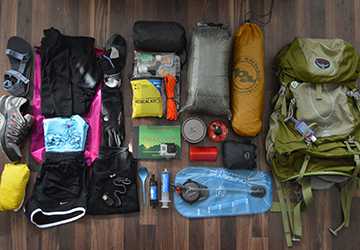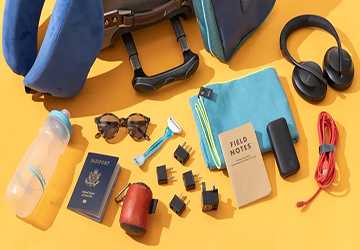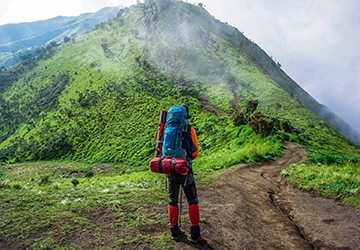4 Essential Packing Hacks for Lightweight Backpacking
Backpacking in nature allows us to escape from technology and daily stress. Only the essentials in your backpack and the road ahead count in a beautiful landscape. However, moving multiple heavy objects quickly can cause physical and mental fatigue. Before you go on your next adventure, implement these packing tips to lighten your load. Not only will your outdoor experience be vastly improved, but you will also be able to go further. Read on to learn how to pare down your backpack to the essentials without sacrificing the essentials.

4 Best Packing Tips for a Lightweight Backpack
When backpacking, every gram counts. Let's discuss four tips for minimizing your backpack's weight while being prepared.
1. Check your existing equipment
The first step in packing is to start at home and figure out what's in your closet. Analyze each item by asking the following questions: Do I really need this for my trip? Stay objective and realistic about your needs; often, our eyes are bigger than our outdoor needs. For example, a camping chair looks comfortable but is a heavy luxury item that should be left behind. Sleeping pads provide adequate cushioning and insulation. When weather requires additional equipment, use your best judgment.
2. Use multifunctional devices
Originality allows certain items to transcend a single function and transform into multifunctional tools. Equipment such as forks, bandanas, trekking poles, and carabiners can perform various tasks. The headscarf consists of a clean handkerchief, a towel, a pot clamp, a headband, and a sling. The carabiner securely attaches the device from the outside and reduces internal bulk. Reusing equipment allows items to be compacted without losing their necessity—or share. For example, coordinate a community tent or stove with a hiking partner. Consolidating equipment reduces duplication. Combined with Lightning Packaging, this can result in significant ounce savings. Ingenuity and collaboration make it possible to go further and faster.
3. Choose low-tech products as much as possible
Hiking veterans know cutting-edge technology can often unnecessarily add weight to a pack. They evaluate each high-tech project by asking whether a low-tech option would be sufficient to achieve the same purpose. Do standard headlamps provide adequate hands-free lighting? Can a simple water bottle replace a complex filtration system? When travelling light, only bring the essentials. Even without adding weight, simple and proven tools often serve their purpose. Invest your limited funds into improving essential gear like your backpack, sleeping bag, and hiking boots for future adventures. Save money on add-ons when simpler, lighter alternatives are available.

4. Review your food choices
Common dehydrated ingredients offer nutritious and lighter options when meal planning compared to canned or bottled foods. Repackaged foods like beans, lentils, pasta, rice, quinoa, nuts, seeds, nut butter and jerky provide more energy and satiety per ounce. Supplement your diet with light comfort foods like hard cheese, chocolate, or cider packets to boost motivation to keep going. Bring minimal cooking utensils; for example, avoid pots and pans if the ingredients in the meal only require hot water. Alternatively, cold soak it to avoid carrying a stove and fuel. Calculate daily rations, taking into account the need for each meal, snack, and hot drink. This will prevent you from carrying too much luggage and allow you to continue logging miles.
Conclusion
Implementing these packing tips will allow you to deeply immerse yourself in nature without being burdened by unnecessary equipment.
Go farther, faster, and immerse yourself in the easy freedom of the trails. Not to mention more space to store travel memories, such as photos, journals, or geological samples found along the way. Share your tips for packing light in the comments below!
Frequently Asked Questions
Q: Are there other ways to reduce the weight of a backpack?
Answer: Remove any unnecessary tape, labels, or packaging from the equipment. For example, remove retail tags or cut off excess buckle straps. Share more oversized communal items with hiking partners, such as tents or stoves. Rent large equipment once you arrive at your destination. Choose lightweight shoes, clothing, and rain gear.
Q: What are the most affordable options for backpacking accommodation?
Answer: Tarp tent systems provide the lightest shelter while still protecting against insects and weather. Look for silnylon or styrene tarps that weigh less than 20 ounces. For solo travel, camping bags under 2 pounds make travelling easy and ultra-light. Just pay attention to breathability. An ultralight one-person tent that weighs about 3 pounds also works well.
Q: What nutrition planning tips can help reduce backpack weight?
Answer: Calculate your rations accurately to avoid carrying too much. Pack meals into lightweight ziplock bags and store them in odour-proof bags to keep them organized while reducing weight. Choose nutritious and small snacks to satisfy your hunger - nuts, seeds, nut butter, jerky or energy bars. Bring some of your favourite foods to inspire you.





